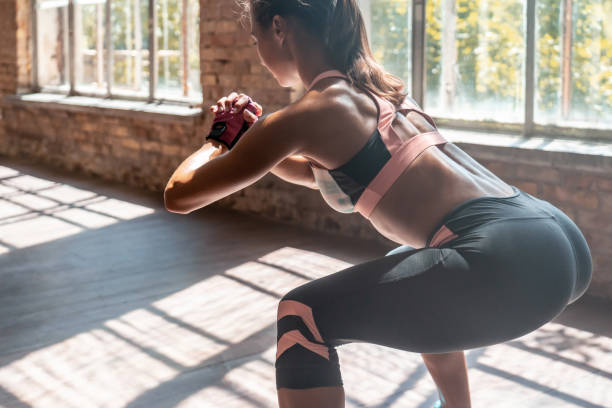Whether you’re aiming to sculpt lean muscle, improve lower body strength, or enhance overall athletic performance, mastering the bodyweight squat is a fundamental step on your fitness journey. Let’s take a closer look at the benefits of bodyweight squats, proper form techniques, variations to keep your routine exciting, and tips for progression as you advance in your fitness pursuits.
The Power of Bodyweight Squats
1. Strengthens Lower Body Muscles
Bodyweight squats primarily target the muscles of the lower body, including the quadriceps, hamstrings, glutes, and calves. By engaging these muscle groups in a coordinated manner, squats help to build strength, power, and endurance in the legs, leading to improved athletic performance and functional movement patterns.
2. Enhances Core Stability
While squats are often thought of as a leg exercise, they also require significant activation of the core muscles to maintain proper posture and stability throughout the movement. By engaging the muscles of the core, including the abdominals and lower back, squats help to improve overall core strength and stability, which is essential for maintaining proper alignment and preventing injury during various activities.
3. Promotes Joint Health
Performing bodyweight squats through a full range of motion helps to improve joint mobility and flexibility, particularly in the hips, knees, and ankles. This can help to reduce the risk of injury and alleviate stiffness or discomfort associated with sedentary lifestyles or prolonged periods of sitting.
4. Boosts Metabolism
As a compound exercise that recruits multiple muscle groups simultaneously, bodyweight squats have the potential to elevate heart rate and increase calorie expenditure. Incorporating squats into your workout routine can help to promote fat loss, improve metabolic health, and enhance overall cardiovascular fitness.
5. Functional Movement Pattern
The squat is a fundamental human movement pattern that mimics everyday activities such as sitting down, standing up, and lifting objects from the ground. By mastering proper squat mechanics, you can improve your ability to perform these activities with ease and efficiency, leading to greater independence and quality of life.
Proper Form Techniques
1. Stance
Stand with your feet shoulder-width apart or slightly wider, toes pointed slightly outward. Ensure that your weight is evenly distributed between your heels and the balls of your feet.
2. Posture
Keep your chest lifted, shoulders pulled back and down, and spine in a neutral position. Engage your core muscles to maintain stability throughout the movement.
3. Descent
Initiate the movement by bending at the hips and knees, as if you’re sitting back into an imaginary chair. Lower your body down until your thighs are parallel to the ground or slightly below, ensuring that your knees track in line with your toes.
4. Ascent
Press through your heels to drive yourself back up to the starting position, fully extending your hips and knees at the top of the movement. Squeeze your glutes at the top to maximize engagement of the posterior chain muscles.
5. Breathing
Inhale as you lower your body down into the squat, and exhale as you push yourself back up to the starting position. Focus on maintaining a steady and controlled breathing pattern throughout the exercise.
Variations to Spice Up Your Routine
1. Narrow Stance Squat
Perform squats with your feet together or in a narrow stance to target the inner thigh muscles and improve balance and stability.
2. Wide Stance Squat
Stand with your feet wider than shoulder-width apart to target the outer thigh muscles and glutes, while also improving hip mobility and flexibility.
3. Jump Squat
Add an explosive element to your squats by incorporating a jump at the top of the movement, increasing power output and calorie burn.
4. Pistol Squat
Challenge your balance and unilateral leg strength by performing squats on one leg, gradually lowering your body down until your non-working leg is extended in front of you.
5. Bulgarian Split Squat
Elevate one foot behind you on a bench or platform and perform squats with the other leg, targeting the quads, hamstrings, and glutes while also improving hip mobility and stability.
Tips for Progression
1. Increase Reps or Sets
Gradually increase the number of repetitions or sets performed during your squat workouts to progressively overload the muscles and stimulate growth and strength gains.
2. Add Resistance
Incorporate external resistance, such as dumbbells, kettlebells, or resistance bands, to make squats more challenging and further stimulate muscle growth and strength development.
3. Experiment with Tempo
Play with the tempo of your squats by slowing down the eccentric (lowering) phase of the movement or adding pauses at the bottom to increase time under tension and maximize muscle engagement.
4. Try Advanced Variations
Once you’ve mastered the basic squat movement pattern, experiment with more advanced variations and progressions to continue challenging your muscles and avoiding plateaus in your training.
5. Listen to Your Body
Pay attention to how your body responds to squatting exercises and adjust your training intensity and volume accordingly. Listen to any signals of discomfort or fatigue and prioritize proper form and technique to prevent injury.
Bodyweight squats are a versatile and effective exercise that can benefit individuals of all fitness levels and goals. By mastering proper form techniques, exploring variations to keep your routine exciting, and implementing progressive overload strategies, you can unlock the full potential of this fundamental movement pattern and take your fitness journey to new heights.
